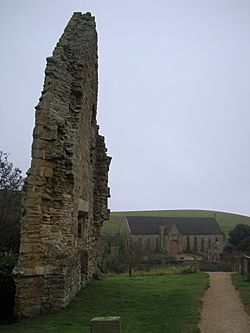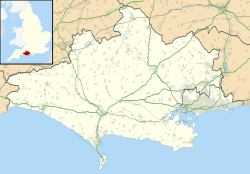Abbotsbury Abbey facts for kids

Abbotsbury Abbey remains and the abbey barn
|
|
| Monastery information | |
|---|---|
| Order | Benedictines |
| Established | 11th century |
| Disestablished | 1539 |
| Dedicated to | St Peter |
| Site | |
| Location | Abbotsbury, England |
| Coordinates | 50°39′52.1″N 2°35′55.4″W / 50.664472°N 2.598722°W |
| Visible remains | tithe barn, parts of a building (possibly the abbot's house) |
| Public access | yes |
Abbotsbury Abbey was a Benedictine monastery in the village of Abbotsbury in Dorset, England. It was dedicated to Saint Peter. A monastery is a place where monks live and work together, following religious rules.
The abbey was started in the 11th century. A powerful Anglo-Saxon lord named Orc and his wife Tola founded it. They gave the monastery a lot of land in the area. Abbotsbury Abbey grew and became very important locally. It controlled eight manor houses and villages.
Later, the abbey faced many challenges. During the time of the dissolution of the monasteries, the last abbot gave up the abbey. The land then became the property of Sir Giles Strangways.
Today, only a small part of the old Abbey remains. These ruins, along with the nearby St Catherine's Chapel, are looked after by English Heritage.
How the Abbey Started
The first mention of Abbotsbury might be in a old document from King Edmund (who ruled from 939 to 946). This document talks about land given to a lord named Sigewulf. The name Abbedesburi suggests that the land might have once belonged to an abbot, who was the head of a monastery.
During the rule of King Cnut (1016–1035), a Scandinavian lord called Orc and his wife Tola moved to the area. They were given land nearby. Later, Edward the Confessor (1042–1066) also gave Orc more land. Early in Edward's reign, Orc and Tola decided to build a monastery at Abbotsbury. There was already a small church there.
Orc and Tola had no children, so they gave a lot of their land to the new monastery. Some of this land was given after they died. By the time of the Domesday Book survey, Abbotsbury Abbey owned a large amount of land. This showed how rich and powerful the abbey had become.
Challenges and the End of the Abbey
The 14th century was a tough time for Abbotsbury Abbey. The Black Death, a terrible disease, killed many people in the village, including the abbot. Also, the village was often attacked from the sea, which made the abbey less safe. Soldiers sent to protect the coast sometimes caused problems too.
Things started to get better for the Abbey in the late 14th and 15th centuries. They even did some new building. But then came a huge change. In the 1530s, King Henry VIII decided to close down all the monasteries in England. This was called the Dissolution of the monasteries.
In 1539, the last abbot of Abbotsbury, Roger Roddon, had to give up the abbey. This happened after a visit from a royal official named Dr. Thomas Legh. He was a lawyer and diplomat who traveled around closing monasteries. He was known for being very strict with the monks.
When the abbey was closed, Abbot Roger Roddon and eight other monks received money to live on. This was called a pension. The village of Abbotsbury became much poorer after the abbey closed.
The abbey buildings and land were then sold to Sir Giles Strangways. He was the official who had helped close the monastery. He bought the abbey buildings, manor houses, water mills, and the famous Abbotsbury Swannery. He paid a lot of money for it, about £1,906. Much of this land still belongs to his family today, the Earls of Ilchester.
What Remains Today
When Abbotsbury Abbey was closed, most of it was pulled down. This was common, as the stone was often reused for other buildings.
However, some parts were saved. The Great Barn, built in the 14th century, is one of them. It is very long, about 272 feet by 31 feet. It is said to be the largest thatched tithe barn in the world. Even though only half of its roof remains, it is still very impressive. It has two large entrances, each with a small room above it.
St Catherine's Chapel was also saved. It was once used as a lookout point over the sea and helped sailors find their way. Both the Great Barn and St Catherine's Chapel are now protected as important historic buildings.
In the churchyard near the local church, you can still see parts of the old abbey church. Another part that survived is a wall that might have been part of the abbot's house, where you can see two old fireplaces. Other ruins might have been part of the guesthouse, which was a place where travelers could find safe shelter.
Not far from the abbey ruins, the former swannery (a place where swans live) has become a famous nature reserve.
Burials
- Humphrey Stafford (died 1413) and wife Elizabeth d'Aumale Mautravers Stafford
- Sir John Mautravers
- Humphrey Stafford (died 1442)



